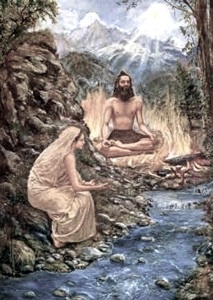The Hermit in Retreat
The Vanaprastha stage is one of gradual withdrawal. The person's duty as a householder comes to an end: He has become a grandfather, his children are grown up and have established lives of their own. At this age, he should renounce all physical, material, and sexual pleasures, retire from his social and professional life and leave his home for a forest hut where he can spend his time in prayers.

The hermit is allowed to take his spouse along with him but maintains little contact with the rest of the family. The role of the third ashrama is to be consulted as elders by the community at large, teaching dharma to those who visit. This kind of life is indeed very harsh and cruel for an aged person. No wonder, this third ashrama is now nearly obsolete.
The stage of Vanaprastha, in particular, is ignored in the modern world. Nowadays, the information and technology people learn about as young adults becomes obsolete by the time they reach the age of Vanaprastha. Thus, the purpose of sharing one’s life work has lost some of its meaning, and there is a greater anticipation of death.
